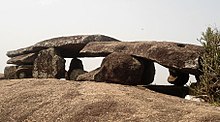
Back Долмен ADY Dolmen AN دلمن Arabic Dolmen AST Dolmen Azerbaijani Дальмен Byelorussian Долмен Bulgarian Liac'hven Breton Dolmen Catalan Dolmen Czech


A dolmen (/ˈdɒlmɛn/) or portal tomb is a type of single-chamber megalithic tomb, usually consisting of two or more upright megaliths supporting a large flat horizontal capstone or "table". Most date from the Late Neolithic period (4000–3000 BCE) and were sometimes covered with earth or smaller stones to form a tumulus (burial mound). Small pad-stones may be wedged between the cap and supporting stones to achieve a level appearance.[1] In many instances, the covering has eroded away, leaving only the stone "skeleton".
In Sumba (Indonesia), dolmens are still commonly built (about 100 dolmens each year) for collective graves according to lineage. The traditional village of Wainyapu has some 1,400 dolmens.[2]
- ^ Murphy (1997), p. 43.
- ^ Jeunesse, Christian; Bec-Drelon, Noisette; Boulestin, Bruno; Denaire, Anthony (2021). "Aspects de la gestion des dolmens et des tombes collectives actuels dans les sociétés de l'île de Sumba (Indonésie)" [Ethnoarchaeology of funeral practices: aspects of the management of current dolmens and collective tombs in the tribal societies of Sumba Island (Indonesia)]. Préhistoires méditerranéennes (in French). 9 (2): 165-179 (see § 8). Retrieved 2024-06-15.
© MMXXIII Rich X Search. We shall prevail. All rights reserved. Rich X Search